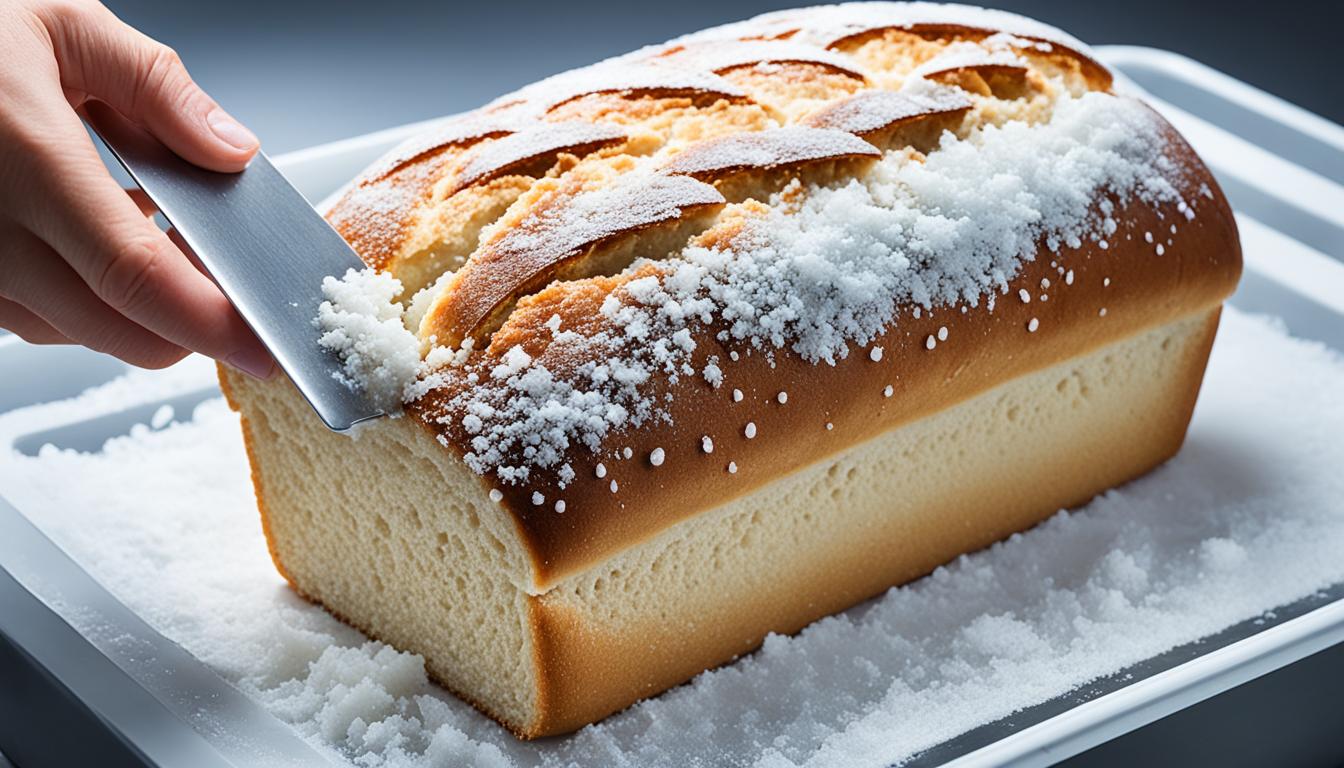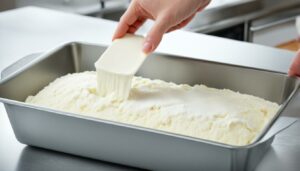Originally posted on March 26, 2024 @ 8:08 pm
Have you ever found yourself with extra bread dough or a freshly baked loaf that you just can’t finish in time? Don’t let it go to waste! Freezing bread dough or homemade bread is a fantastic way to preserve its freshness and extend its shelf life. But can you really freeze your bread recipe with confidence? Let’s find out!
Contents
- 1 Types of Bread that Freeze Well
- 2 Preparing Homemade Bread for Freezing
- 3 Proper Storage and Thawing Techniques
- 4 Freezing Bread Dough
- 5 Make-Ahead Baking: Tips and Tricks
- 6 Types of Baked Goods to Freeze
- 7 Freezing and Thawing Techniques for Different Baked Goods
- 8 Conclusion
- 9 FAQ
- 9.1 Can I freeze my bread recipe?
- 9.2 What types of bread freeze well?
- 9.3 How do I prepare homemade bread for freezing?
- 9.4 What are the proper storage and thawing techniques for frozen bread?
- 9.5 How do I freeze bread dough?
- 9.6 What are some tips for make-ahead baking?
- 9.7 What types of baked goods can be frozen?
- 9.8 How do I freeze and thaw different types of baked goods?
- 9.9 How can I freeze my bread recipe with confidence?
- 10 Source Links
Key Takeaways:
- Freezing bread dough or homemade bread is a great way to preserve freshness and extend shelf life.
- Not all types of bread freeze well, but certain varieties like French bread and sandwich bread maintain their texture and flavor after being frozen.
- Properly preparing and storing frozen bread is crucial for maintaining its quality.
- Make-ahead baking and freezing baked goods like cakes, cookies, and muffins can save you time in the kitchen.
- By following the proper techniques, you can confidently freeze your bread recipe and enjoy delicious homemade bread whenever you want.
Types of Bread that Freeze Well
Not all types of bread freeze well, but there are certain varieties that maintain their texture and flavor after being frozen. Some of the best breads for freezing include French bread, Italian bread, sandwich bread, and sourdough bread. These types of bread have a dense and chewy texture that holds up well to freezing and thawing. Additionally, they have a longer shelf life and can be stored in the freezer for several months without losing their quality.
When choosing bread to freeze, opt for loaves that are slightly under-baked to ensure they remain soft and tender after thawing. The moistness of these breads helps to prevent them from drying out during freezing and gives them a better texture when thawed. Whether you prefer a crusty French bread to pair with a soup or a soft sandwich bread for your everyday sandwiches, these breads are ideal for freezing and will provide you with delicious options whenever you need them.
Freezing fresh bread is one of the best ways to ensure you always have a tasty and convenient option on hand. In the next section, we will explore the steps to properly prepare homemade bread for freezing, so you can enjoy the benefits of a well-stocked freezer full of delicious bread recipes.
Preparing Homemade Bread for Freezing
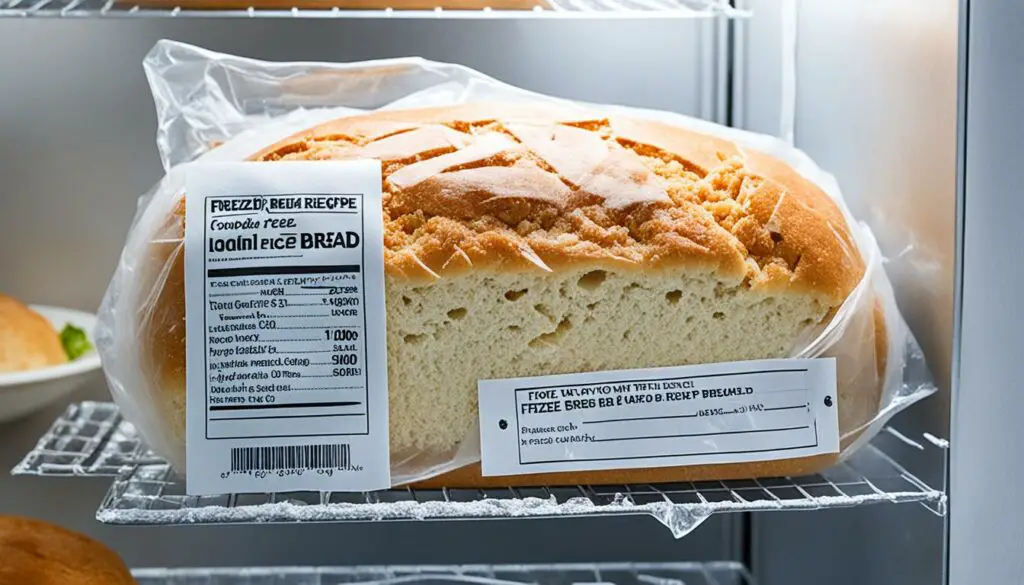
Before freezing your homemade bread, it’s essential to take the necessary steps to ensure it freezes and thaws well. By properly preparing your bread for freezing, you can maintain its freshness and taste. Here are some easy-to-follow instructions:
- Cool the bread: Allow your homemade bread to cool completely before freezing. This will prevent condensation and moisture from forming, which can lead to freezer burn and affect the texture and taste of the bread.
- Slice or leave it whole: Decide whether you want to freeze your bread as whole loaves or sliced. Both options have their advantages. Freezing whole loaves takes up less space and preserves the freshness, while slicing the bread allows for easy portioning and individual servings.
- Wrap it properly: To protect your bread from freezer burn and moisture, wrap it tightly in plastic wrap or aluminum foil. Alternatively, you can place the bread in a sealable plastic bag, removing as much air as possible.
- Label and date: Don’t forget to label your bread with the date of freezing. This will help you keep track of its freshness and ensure that you use older loaves first. Use a permanent marker or adhesive labels to mark the packaging.
By following these simple steps, you can ensure that your homemade bread retains its quality and taste even after freezing. Whether you prefer whole loaves or sliced bread, proper preparation is key to enjoying freshly baked goodness whenever you desire.
Proper Storage and Thawing Techniques
Properly storing and thawing your homemade bread is essential to ensure that it maintains its freshness and flavor. Whether you are freezing an entire loaf or just a few slices, these guidelines will help you maintain the quality of your bread.
When it comes to storing homemade bread, the best option is to freeze it. Freezing bread not only extends its shelf life but also allows you to have freshly baked bread on hand whenever you need it.
To store your homemade bread:
- Allow the bread to cool completely before wrapping it tightly in plastic wrap or aluminum foil. This will prevent it from drying out in the freezer.
- Place the wrapped bread in a freezer-safe bag or container to protect it from freezer burn and absorb any moisture.
- Label the bag or container with the date and type of bread to easily identify it later.
- Store the bread in the freezer at a temperature below 0°F (-18°C).
Pro Tip: Slicing the bread before freezing makes it more convenient to thaw and use as needed.
Thawing frozen bread is a simple process, but it’s important to do it correctly to maintain the texture and flavor:
- Remove the desired number of slices or the entire loaf from the freezer.
- Unwrap the bread and place it on a wire rack or baking sheet to thaw at room temperature.
- Avoid thawing bread in the microwave or oven as it can result in uneven thawing and affect the quality of the bread.
- Allow the bread to thaw completely before consuming it. This usually takes 2-3 hours for sliced bread and 4-6 hours for a whole loaf.
Alternatively, if you only need a few slices and don’t want to thaw the entire loaf, you can use a toaster or toaster oven to toast the frozen slices directly. This method provides a warm and crispy texture.
Tips for Refrigerator Storage
If you prefer to store your bread in the refrigerator instead of the freezer, keep in mind that it will have a shorter shelf life. Refrigerator storage is ideal for bread that will be consumed within a couple of days.
To store bread in the refrigerator:
- Allow the bread to cool completely.
- Wrap it tightly in plastic wrap or aluminum foil to prevent it from drying out.
- Place the wrapped bread in a resealable plastic bag or airtight container to further protect it from moisture and odors.
- Store the bread in the refrigerator at a temperature between 35°F (2°C) and 40°F (4°C).
Pro Tip: Before consuming refrigerated bread, you can refresh it by reheating it in the oven at a low temperature for a few minutes. This will help regain some of its freshness.
Freezing Bread Dough
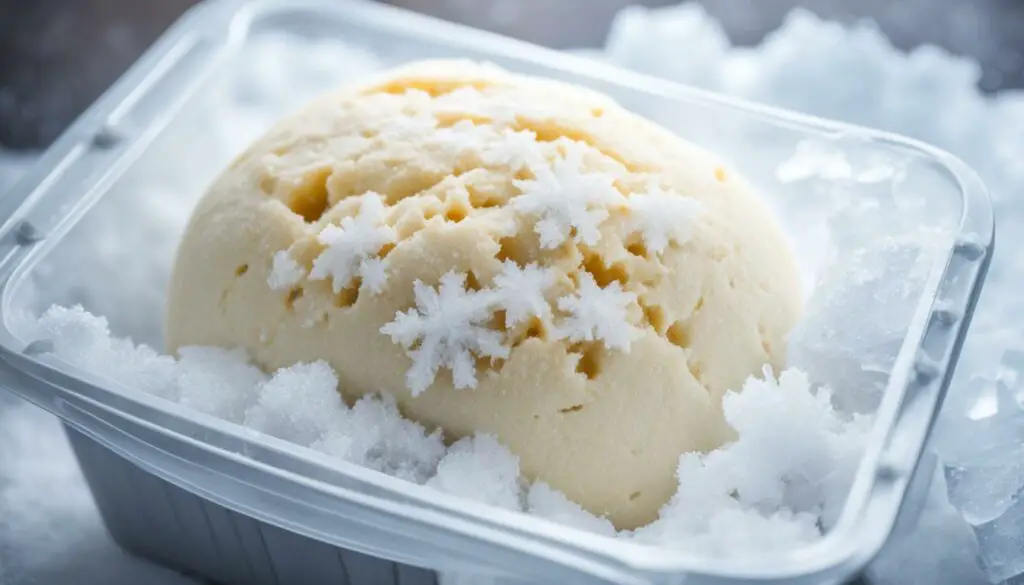
Freezing bread dough is a convenient option for those who want to enjoy fresh bread without the need for extensive preparation. Whether you’re a bread lover or simply want to have dough ready for baking at a moment’s notice, freezing bread dough can be a time-saving solution.
Here are the steps to freeze bread dough:
- Knead the dough until it is smooth and elastic.
- Shape the dough into individual portions or loaves.
- Wrap each portion tightly in plastic wrap, ensuring there are no air pockets.
- Stack the wrapped dough portions in an airtight container or freezer bag.
- Label the container or bag with the date and type of dough.
- Place the container or bag in the freezer, ensuring it is stored flat to prevent misshaping.
When you’re ready to bake the bread, simply remove the desired portion from the freezer and thaw it in the refrigerator overnight. Once thawed, allow the dough to come to room temperature before shaping and baking as usual.
Freezing bread dough allows you to enjoy the freshly baked aroma and taste of homemade bread whenever you want, without the time-consuming process of preparing the dough from scratch.
Here is a table summarizing the steps to freeze bread dough:
| Step | Description |
|---|---|
| 1 | Knead the dough until it is smooth and elastic. |
| 2 | Shape the dough into individual portions or loaves. |
| 3 | Wrap each portion tightly in plastic wrap, ensuring there are no air pockets. |
| 4 | Stack the wrapped dough portions in an airtight container or freezer bag. |
| 5 | Label the container or bag with the date and type of dough. |
| 6 | Place the container or bag in the freezer, ensuring it is stored flat to prevent misshaping. |
Make-Ahead Baking: Tips and Tricks
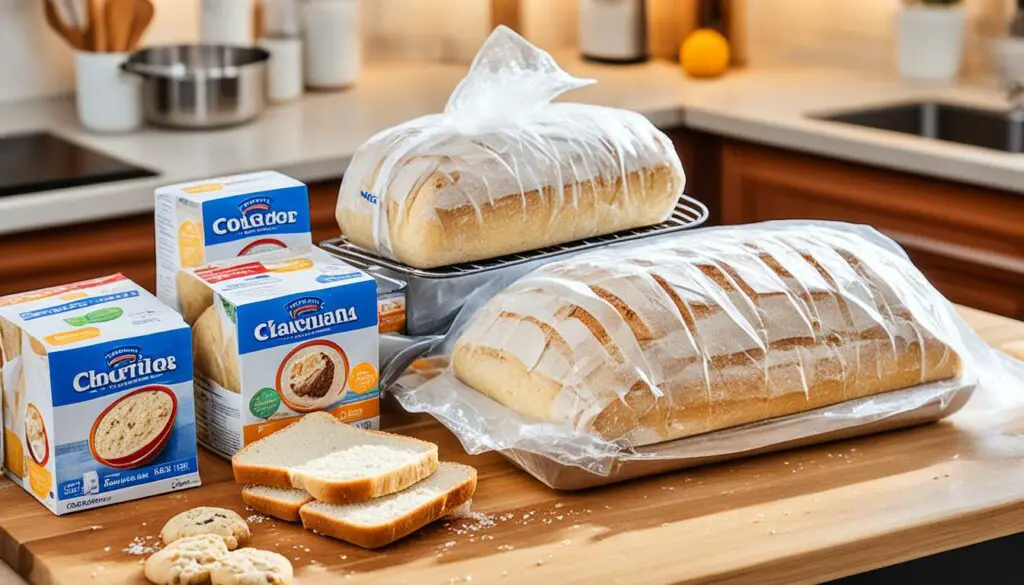
Make-ahead baking is a game-changer when it comes to saving time in the kitchen and ensuring that you always have delicious homemade baked goods at your fingertips. By preparing and freezing bread recipes in advance, you can preserve the taste and quality while cutting down on last-minute preparations. Here are some tips and tricks to help you master the art of make-ahead baking:
- Plan your baking: Take time to plan out your baking sessions, considering the recipes you want to make and the quantity you’ll need. This way, you can make the most of your time and ingredients.
- Choose the right recipes: Not all bread recipes are suitable for make-ahead baking. Opt for recipes that are known to freeze and thaw well. This will ensure that your baked goods maintain their texture and flavors when you’re ready to enjoy them.
- Freeze individual portions: If you’re making items like muffins, scones, or cookies, freeze them in individual portions. This makes it easier to grab and thaw only what you need, reducing waste and ensuring freshness.
- Properly wrap and label: Ensure that you wrap your baked goods tightly in airtight containers or freezer-friendly bags. Label them with the name and date of preparation to easily identify them later on.
- Thawing techniques: When it’s time to enjoy your make-ahead treats, allow them to thaw at room temperature for the best texture and taste. If you’re in a rush, you can use the microwave or oven on low heat to thaw them more quickly.
Make-ahead baking allows you to have a wide variety of homemade treats readily available. Whether you’re hosting a gathering, preparing for busy mornings, or simply satisfying a craving, it’s a convenient way to ensure you always have something delicious on hand.
To help you visualize the benefits of make-ahead baking, here’s a table summarizing the advantages and considerations:
| Advantages of Make-Ahead Baking | Considerations |
|---|---|
| Time-saving | Choosing the right recipes |
| Always having homemade treats available | Proper portioning and storage |
| Reduced last-minute stress | Thawing techniques |
With these tips and tricks, you’ll be well-equipped to master the art of make-ahead baking. Preserving bread recipes, freezing and thawing bread, and enjoying homemade treats whenever you want has never been easier. So go ahead, get creative in the kitchen, and make your baking adventures more convenient and enjoyable!
Types of Baked Goods to Freeze
When it comes to freezing baked goods, there are plenty of options that can be stored for later use. Whether you’re looking to extend the shelf life of your favorite treats or simply want to have a variety of options available for quick and easy snacks, freezing baked goods is a convenient solution. Here are some common baked goods that freeze well:
- Cakes
- Cookies
- Muffins
- Scones
- Quick Breads
These delicious treats can be preserved in the freezer for several months without compromising their taste or texture. When properly wrapped and stored, they retain their freshness, allowing you to enjoy a homemade baked delight whenever you crave it. From indulgent cakes to grab-and-go muffins, freezing baked goods ensures that you always have a tasty option on hand for any occasion.
Freezing and Thawing Techniques for Different Baked Goods
When it comes to freezing and thawing different types of baked goods, it’s important to follow specific techniques to ensure optimal taste and texture. Here are some guidelines to help you freeze and thaw common baked goods:
Bread and Rolls
To freeze fresh bread or rolls:
- Allow the bread or rolls to cool completely before freezing.
- Wrap the bread or rolls tightly in plastic wrap or aluminum foil to prevent freezer burn.
- Place the wrapped bread or rolls in a freezer-safe bag or container.
- Label the bag or container with the date and contents.
- Store the bread or rolls in the freezer for up to 3 months.
To thaw frozen bread or rolls:
- Remove the bread or rolls from the freezer and let them thaw at room temperature.
- Once thawed, reheat the bread or rolls in the oven or toaster to refresh and warm them.
Cakes and Cupcakes
To freeze cakes or cupcakes:
- Allow the cake or cupcakes to cool completely before freezing.
- Wrap the cake or individual cupcakes tightly in plastic wrap or aluminum foil.
- Place the wrapped cake or cupcakes in a freezer-safe bag or container.
- Label the bag or container with the date and contents.
- Store the cake or cupcakes in the freezer for up to 3 months.
To thaw frozen cakes or cupcakes:
- Remove the cake or cupcakes from the freezer and let them thaw in the refrigerator overnight.
- Once thawed, allow the cake or cupcakes to come to room temperature before serving.
Cookies
To freeze cookies:
- Allow the cookies to cool completely before freezing.
- Place the cookies in an airtight container or freezer-safe bag.
- Label the container or bag with the date and contents.
- Store the cookies in the freezer for up to 3 months.
To thaw frozen cookies:
- Remove the cookies from the freezer and let them thaw at room temperature.
- Once thawed, the cookies can be enjoyed as is or warmed in the oven for a fresh-baked taste.
Pies and Tarts
To freeze pies or tarts:
- Prepare the pie or tart as usual and allow it to cool completely.
- Wrap the pie or tart tightly in plastic wrap or aluminum foil.
- Place the wrapped pie or tart in a freezer-safe bag or container.
- Label the bag or container with the date and contents.
- Store the pie or tart in the freezer for up to 3 months.
To thaw frozen pies or tarts:
- Remove the pie or tart from the freezer and let it thaw in the refrigerator overnight.
- Once thawed, the pie or tart can be served chilled or reheated in the oven for a warm, flaky crust.
| Baked Good | Freezing Techniques | Thawing Techniques |
|---|---|---|
| Bread and Rolls | Wrap tightly and store in a freezer-safe container or bag. | Thaw at room temperature and reheat in the oven or toaster. |
| Cakes and Cupcakes | Wrap tightly and store in a freezer-safe container or bag. | Thaw in the refrigerator and allow to come to room temperature before serving. |
| Cookies | Store in an airtight container or freezer-safe bag. | Thaw at room temperature. |
| Pies and Tarts | Wrap tightly and store in a freezer-safe container or bag. | Thaw in the refrigerator and serve chilled or reheat in the oven. |
Conclusion
Freezing fresh bread is a game-changer for bread lovers. Whether you want to preserve your homemade bread recipes or have a stash of ready-to-bake dough, freezing is a convenient and practical option. By following the proper storage and thawing techniques, you can enjoy the same quality and taste of freshly baked bread, even after freezing.
Preserving bread recipes starts with proper preparation. Make sure your bread is cooled completely before freezing to avoid excess moisture and prevent ice crystals from forming. Wrap the bread tightly in plastic wrap or place it in freezer-safe bags. For homemade dough, shape it into loaves or rolls before freezing. This way, you can quickly bake them whenever the craving strikes.
When you’re ready to enjoy your frozen bread, thaw it at room temperature or in the refrigerator. Avoid using the microwave or hot oven, as this can dry out the bread. Remember, freshly baked bread is just a few simple steps away!
Whether you’re planning ahead for special occasions or simply want to have a stockpile of delicious bread, freezing is a fantastic option. With the right techniques and a bit of planning, you can confidently freeze your bread recipes and savor the taste of homemade bread anytime you want.
FAQ
Can I freeze my bread recipe?
Yes, you can freeze your bread recipe to preserve its freshness and extend its shelf life.
What types of bread freeze well?
French bread, Italian bread, sandwich bread, and sourdough bread are some of the best breads for freezing.
How do I prepare homemade bread for freezing?
To prepare homemade bread for freezing, slightly underbake the loaves to ensure they stay soft after thawing.
What are the proper storage and thawing techniques for frozen bread?
Store frozen bread in airtight bags or containers and thaw it at room temperature or in the refrigerator.
How do I freeze bread dough?
To freeze bread dough, shape it into loaves or rolls, wrap it tightly in plastic or foil, and place it in the freezer.
What are some tips for make-ahead baking?
Make-ahead baking can save time in the kitchen. Some tips include freezing baked goods in individual portions and labeling them with the date.
What types of baked goods can be frozen?
Cakes, cookies, muffins, scones, and quick breads are just a few examples of baked goods that freeze well.
How do I freeze and thaw different types of baked goods?
Different baked goods require slightly different freezing and thawing techniques. For example, cookies can be frozen in an airtight container, while cakes should be wrapped in plastic and foil.
How can I freeze my bread recipe with confidence?
By following the proper techniques and tips for freezing bread, you can confidently freeze your bread recipe and enjoy delicious homemade bread whenever you want.

